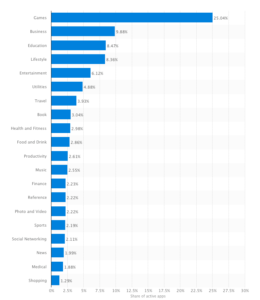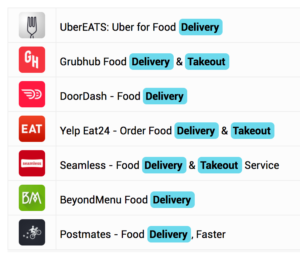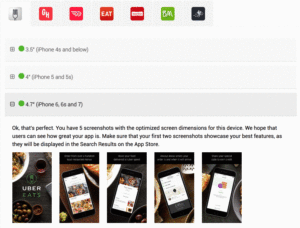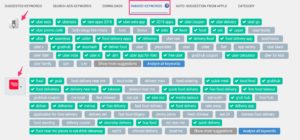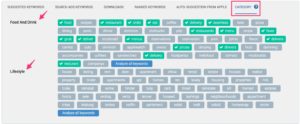Incipia blog
How to do your initial App Store Research: for Startup Founders
This is a guest post by Laurie Galazzo of ASO tool, AppTweak, targeted towards new app business entrepreneurs, founders, marketers, and developers planning App Store Optimization for a new app launch.
So your app is finally ready to be published on the Apple App Store or the Google Play Store! You’ve also heard about the importance of App Store research and App Store Optimization (ASO). However, you don’t really know where to start in order to maximize your app's potential for discoverability. Follow this step-by-step guide, full of actionable tips, and give your app an impactful competitive edge!
----------
The Benefits of App Store Research
As a startup founder, you probably have already faced a lot of challenges. At first, you had to find a great product or service idea. Then, you had to turn this idea into a concrete and functional mobile app, which is hopefully answering a specific problem or precise need, while providing the market with something that does not exist yet - or that offers something better than what exists.
You’ve probably also struggled to raise some funds or to find associates and/or employees. Or maybe neither of those as you’ve decided go “solo”, with no team and no budget.
Either way, you’ve reached the moment of being ready to publish your app to the store! Congratulations: this is a key moment for you and your business, as it is - hopefully - the beginning of your success story.
Building a great app is a good start, but your work definitely does not stop here. With nearly 3 million of apps on both the Apple App Store and the Google Play Store, the increasing competition makes it difficult to stand out from other apps and actually be discovered.
Along with your app-launch marketing strategy (which is hopefully already elaborated, whether on a budget or otherwise), it is important to build an effective App Store Optimization (ASO) strategy and integrate it into your global marketing strategy. Working on your ASO will enable you to increase your app’s visibility and discoverability on relevant keywords, earning you vital, free downloads.
A great start to building your ASO strategy is by performing in-depth App Store research. This will help you to not only understand the market and the current trends, but also to find opportunities for your app and be ready to tackle your competition.
Here are the 3 crucial steps you need to undertake in order to benefit from App Store research for your ASO.
Note: although these tips focus on the Apple App Store, much of the advice can be applied to Google Play Store apps.
1. Choosing the Right App Store Categories
One of the first and most important tasks is to choose a primary and a secondary category for your app. Although this task seems obvious and easy, it can be challenging to find the best categories representing what your app offers accurately, even more-so if your app offers multiple functions. Tinder, for instance, falls under the “Lifestyle” category but could also go under “Social Networking” or “Entertainment” categories.
This is probably the reason why Apple allows you to choose 2 categories for your app. However, bear in mind that the first category is the most important one in terms of app discoverability on the App Store. Indeed, it is in this category that your app will appear when users browse the App Store.
Categories help users to discover apps that may best fit their needs, and enable the algorithm to deliver relevant results on specific search queries. It’s like in the grocery store: you will not look for nor find meat right in the middle of vegetables. Grocery stories are designed to make it easier for shoppers to find what they’re looking for, in a smart and relevant way.
There are 3 elements that you need to take into account before choosing your app’s categories:
1. Relevance: you must choose a category that matches your app’s purpose. Make sure to choose a category that best describes what your app contains or does.
If your app has several functionalities, think of the one that first comes to mind when thinking about your app. Think of the way you would describe or pitch your app.
Don’t forget that your app’s categories names are indexed - there is no need to repeat them in your metadata.
2. Competition: a great way to make your decision is to check your main competitors. Track similar apps to yours and see in which category they are categorized. Make sure to check competitor categories periodically, as they could change at any time.
For researching the competition, there are two main types of strategies:
- Following other apps: It can be easier at the beginning to align your app with your competition, given that users most likely associate your app’s type with that category.
- Using another category to stand out: on the other hand, you might want to try going with another category that may be a little less relevant, but less competitive.
We recommend starting with the first strategy and then testing the second one once your app has been in the store for a little while.
It is also interesting to look at the overall competition within App Store categories. Here’s the breakdown for the United States App Store.
Image Source: Statista
With over 25% of total apps, the “Games” category is clearly leading the App Store. Given this impressive level of competition, you can choose two Games subcategories to categorize your app and facilitate search.
Taking out the top 5 leading categories, the amount of apps across categories seems to be equally spread. It is actually insightful to see that the interest is concentrated on a specific portion of apps.
A great strategy is to choose the category with the least competition (but is still relevant to your app, of course) in order to increase your chances of being visible. Again, you can test multiple strategies and see what works best for you.
2. Understanding your Competition
Although we already mentioned the importance of competition monitoring to find the best categories for your app, it is crucial to invest some time in an in-depth analysis of your competitors.
We recommend taking the top 10 apps from your app’s primary and secondary categories. Use an Excel sheet to list all their features and strengths. You want to find the characteristics that made them a success and get inspired by them.
On the other hand, you can do the same with a few competitors that are less successful. The point is to detect their flaws and learn about their mistakes - either in terms of product or in terms of app marketing strategy. That way, you’ll avoid repeating what did not work and thus will have more time and resources to focus on what will actually give positive results.
A great way to monitor competitive apps is to list and read their reviews. Make sure to mark down the recurring missing features and bugs that are mentioned. That way, you’ll be able to better understand your target audience (which is not far from your competitors’).
It will also enable you to provide users with features or tools that they are asking for. You’ll also know which technical difficulties they are experiencing, which will hopefully help you anticipate and prevent you from having the same ones.
3. App Store Optimization (ASO) Research
An important aspect of your competition research/monitoring is to track your main competitors’ App Store Optimization (ASO) strategy. This includes monitoring their app title, keywords, app description, visual materials, and all other ASO assets.
Understanding and monitoring your competition will enable you to build your own strategy with valuable insights from theirs. Here again, the first step is to try finding what your competitors have in common.
You can create an Excel sheet listing all the ASO elements and answer the following questions:
- How are they describing their app (which features are mentioned, how’s the structure of their description)?
- Which keywords are they using in their app titles?
- Which features are showcased in their screenshots?
- Do they have an app preview?
- What keywords are they ranking/not ranking for?
- How often do they update their app?
This step will help you to find ideas that will be worth modeling, whether in terms of keywords or design.
On the other hand, it will help you find new tactics and opportunities to explore in order to offer something new. For instance, if none of your competitors are using an app preview, jump on the occasion to publish your own right from the start. It will definitely make a difference.
ASO tools like AppTweak can help you collect App Store data and easily track & compare your competitors’ metadata, keywords, and overall ASO strategy.
To start your analysis on AppTweak, take one of your main competitors’ ASO report. Add some of your closest competitors and compare each metadata.
How to find competitors? You can use AppTweak's “Suggested Competitors” feature to find some competing apps. You can also manually browse Top Charts in your category. Finally, you can do a search on any relevant keyword and take the first apps appearing in the top results. Remember that an app can be your competitor in terms of ASO, while it may not necessarily be in terms of business, and vice versa.
In the example below, we’ve got an easy and clear comparison of UberEATS app and its main competitor's app titles.
Image source: AppTweak
You can also compare their visuals like their screenshots and app preview.
Image source: AppTweak
Finally, lots of time and resources must be dedicated to keyword research. Keyword optimization is probably the most important and yet challenging aspect of App Store Optimization.
Given that over 65% of downloads are made through search in the App Store (and general browsing), it is crucial to optimize your app’s organic visibility and discoverability.
There are multiple ways through which you can find the most appropriate and powerful keywords to target.
Generally, we advise you to create a big spreadsheet of relevant keywords related to your app. Try coming up with as many keywords or keyword combinations that you can think of which would make sense and that could be used to find/download your app. Keep in mind your target audience and try thinking of how they would look for your app. Are you targeting teenagers or elderly people? Males or females? Think of how they would make a search.
Don’t forget that the App Store algorithm pays great attention to conversion rates - don’t use keywords that have low relevance to do with your app as they will not drive any downloads or, worse, they will bring you uninstalls, which is bad for your rankings.
Again, it is also crucial to spy on your competitors. Benchmarking your competition and screening their keywords rankings is a great way to guess their iTunes Connect Keyword field. Not only will you get inspiration for your own keywords selection, you’ll also perhaps come up with clever ways to outrank them.
Ranked Keywords
Obviously, you can do this research manually but it is always easier to use an ASO tool, as it will save you a lot of time!
AppTweak's “Ranked Keywords” feature provides a list of the keywords ranking any given app in the first 100th position in the search results.
In other words, you can check to see which keywords your competitors are performing the best for, in terms of rankings. Here again, it’s insightful to list the occurrences in order to establish your own strategy.
Image source: AppTweak
Other resources to find keywords for your app
- Category Keywords
It is interesting to look at the most popular keywords from your primary and secondary categories. You can do the job manually or use AppTweak “Category Keywords” feature to check which are the Top keywords used by the Top apps in any given category.
In other words, if you’re wondering which are the best keywords for Top apps in the “Food & Drink” or “Lifestyle” categories, you’re only one click away!
Image source: AppTweak
- Auto-suggestions
As you may already know, the Apple App Store provides users with autocomplete suggestions as they start typing their search query. These suggestions are highly used by store users: they are therefore very popular terms.
Auto-suggestions are thus an interesting source of inspiration for your keywords selection. It is also a great way to find popular long tail keywords (or keyphrases).
Note: to target long tail keywords and combined keyphrases, use single keywords separated by a comma in your iTunes Connect Keyword Field. The algorithm will make the association and combine keywords automatically.
You can use AppTweak or AppKeywords.io (a free tool) to find auto-complete keywords by Apple and Google.
- Search Ads Recommended and Related Keywords
With the arrival of Search Ads and the ability to bid on any specific keyword, Apple has introduced a series of tools and indicators to encourage app developers and marketers to actually use this new acquisition method.
It is very interesting to look at the suggestions offered by Apple for similar apps to yours (“Recommended keywords”). You can also get a list of “Related keywords” by entering any term on the Search Ads console (or, again, on AppTweak).
Once more, these keywords are a great source of inspiration that you can use during your Keywords Research for your organic selection.
It is also interesting to analyze on which keywords your competitors are bidding but also which apps are bidding on specific relevant keywords from your field. (Newly launched feature available on AppTweak!).
- Trending Keywords
You can also take a look at the “Trending Keywords”, which are the most popular searches in the App Store (per country). Although these are extremely competitive, their level of popularity makes them worth to consider if they happen to be linked with your app’s purpose.
Conclusion
There are many different sources of data that you can explore in your App Store Research. It is recommended to use the available data and insights to build your own tactic and maximize your potential to outrank your competitors.
Don’t forget to complete your Keywords Research with relevant indicators like the Search Popularity (Volume of search) or the Competition (Difficulty) in order to make the best selection possible.
Try finding keywords with a moderate volume but a low competition at the beginning. Then, as your popularity grows, you will be ready to tackle more popular keywords. Make sure to check this ultimate iOS keywords guide and don’t forget that Apple has introduced a new App Store for iOS 11.
The App Store is growing rapidly and the trends are evolving every day. You need to work regularly on your App Store Optimization and App Marketing Strategy. The best practice consists in adapting your ASO throughout an ongoing process of iterations and monitoring.
Good luck with your app launch and don’t forget to update your ASO about every 4 weeks!
AppTweak is an automated App Store Optimization platform empowering app developers and marketers to increase their app rankings and app users.
Categories
Tags:
- A/B testing
- adjust
- advertising
- adwords
- agile
- analytics
- android development
- app analytics
- app annie
- app development
- app marketing
- app promotion
- app review
- app store
- app store algorithm update
- app store optimization
- app store search ads
- appboy
- apple
- apple search ads
- appsee
- appsflyer
- apptamin
- apptweak
- aso
- aso tools
- attribution
- client management
- coming soon
- design
- development
- facebook ads
- firebase
- google play
- google play algorithm update
- google play aso
- google play console
- google play optimization
- google play store
- google play store aso
- google play store optimization
- google uac
- google universal campaigns
- idfa
- ios
- ios 11
- ios 11 aso
- ios 14
- ios development
- iot
- itunes connect
- limit ad tracking
- ltv
- mobiel marketing
- mobile action
- mobile analytics
- mobile marketing
- monetization
- mvp
- play store
- promoted iap
- promoted in app purchases
- push notifications
- SDKs
- search ads
- SEO
- skadnetwork
- splitmetrics
- startups
- swift
- tiktok
- uac
- universal app campaigns
- universal campaigns
- user retention
- ux
- ux design
